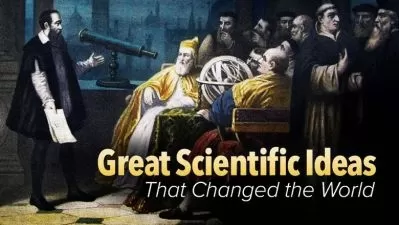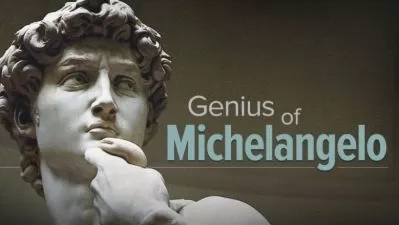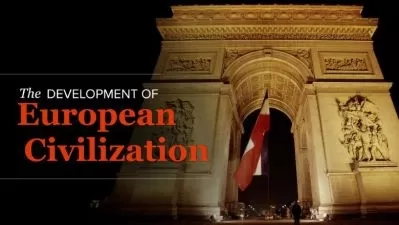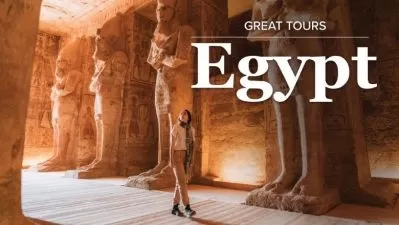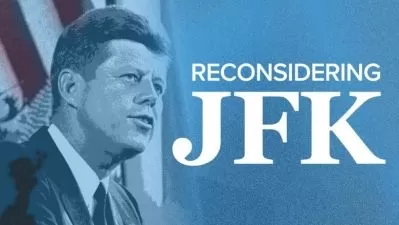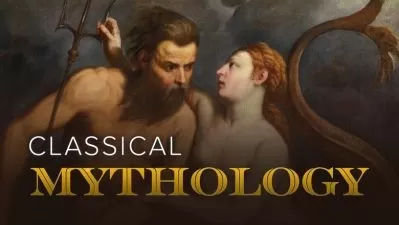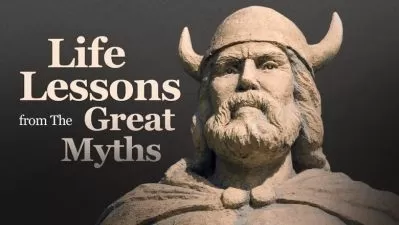Great Mythologies of the World
Taught By Multiple Professors
31:45:31
Description
Great Mythologies of the World: Ancient Europe
Odysseus and the Sirens, Jason and the Argonauts, Romulus and Remus, Odin and Thor—the stories of these larger-than-life figures have circulated for thousands of years. These story cycles not only reflect the cultures of their origin, but they have also shaped subsequent literary, dramatic, and other artistic traditions, and they still have currency today. We call these stories the “great mythologies” because of their rich characters, engaging narratives, enduring motifs, and timeless themes.
In the first section of this course, we’ll look at some of the most influential and engaging ancient Greek, Roman, Celtic, and Norse myth traditions. We’ll begin with the Greeks, acknowledging the deep debt that Western art, literature, philosophy, and religion owe to Greek mythology. We look first at the Titans and the Olympic gods, the gods intimately associated with creation. Then, we turn to the most prominent goddesses, reflecting on the unique roles Greek goddesses played—and didn’t play—in Greek society. We’ll recall stories of the gods who had a direct impact on human daily life: Prometheus, Pandora, and Persephone. Finally, we’ll look at the heroes of Greek mythology—Herakles, Odysseus, and Jason—and ponder the highs and lows of the Greek hero.
Next, we’ll turn to Rome, which embraced much of Greek mythology yet generated an origins story of its own. A common mythological figure—the Great Mother—made her way to Rome in the form of Cybele, then transformed there, from the wild woman of Anatolia to the respectable savior of Rome. Finally, we’ll turn northward, to Celtic and Norse mythology. The Dagda, the good god of Celtic traditions, and his magical harp are emblematic of the courageous yet flawed heroes who established Ireland with the help of powerful objects and supernatural powers. The Celtic mythological characters and imagery persist in Irish culture to this day. The Norse traditions highlight the harsh conditions under which Norsemen and women labored, but they also include unexpected streaks of humor in the character of Loki and the misadventures of Thor. At the same time, we feel the compassion in Odin, the father god, who carries the weight of the world on his shoulders while battling with wolves, riddling with giants, and sacrificing himself to obtain mystical insight.
Throughout this course, we’ll also think about the significance of myth more broadly. What makes these stories such powerful cultural elements? What do they tell us about the cultures that gave birth to them? Why have they persisted for hundreds, even thousands of years? We’ll see that myths reflect social structures, key historical moments and trends, and deeply held cultural values. They also have lives of their own, shape-shifting as they move from age to age and from culture to culture. Myths survive where political dynasties collapse because they speak intimately and effectively to the human experience.
Great Mythologies of the World: The Middle East and South Asia
The word mythology tends to evoke traditions in the Western canon, especially the Greek and Roman traditions. But cultural communities from all around the globe offer rich bodies of mythology. In this section of the course, we’ll look at the great myths of ancient Babylon, Mesopotamia, Egypt, Israel, the Persian Empire, and West and South Asia. As in the West, these mythologies infused literary, musical, theatrical, and visual art forms, and they reflected the social, political, economic, and cultural contexts in which they were shaped. We’ll also see, however, that non-Western mythological traditions display distinctive characteristics. These myth traditions rarely make a sharp distinction between the mundane world and the transcendent divine world—characters frequently navigate these worlds simultaneously, dealing with familiar, everyday problems, along with supernatural beings and elements. Also, the landscape—and making one’s way through the landscape—often figures prominently in these traditions. Natural elements have power and significance; in many cases, they figure as characters in Middle Eastern and South Asian stories.
These mythologies also spend a great deal of time exploring the relationship between wilderness and civilization, between order and chaos, between the realms dominated by humans and those that elude human control. They ask such questions as: Who’s civilized? Who’s wild? And what do those designations mean in the grand scheme of things?
Finally, the great non-Western mythologies emphasize social roles, including those determined by gender. Of course, all the world’s mythologies explore gender and power, but the non-Western story traditions play with the tensions created by gender and socially determined roles in a surprising variety of ways.
Although the ancient Mesopotamian, Egyptian, Middle Eastern, and South Asian mythologies introduce many of us to new worlds, they also underscore the common concerns humanity has shared over the millennia. Gilgamesh, king of the world’s greatest city, learns about friendship and grieves for his own mortality. Ra feels unappreciated by the human beings he rules, and because of this feeling of neglect, he acts rashly, nearly wiping out the entire human race. Job asserts his righteousness repeatedly, only to discover that upright behavior is no bulwark against suffering. And Scheherazade shows us the power of good storytelling for the human psyche.
In this section of the course, we’ll also note some common themes and motifs across the Egyptian, Middle Eastern, and South Asian traditions. We’ll review several creation stories and discuss why many cultures pass on multiple stories about the origins of the world and humanity. We’ll also talk about the common motifs of flood and fire, which feature repeatedly in stories about the beginning and end of the world. Finally, we’ll examine the seemingly contradictory nature of myth itself. How do myths contribute to—in addition to reflecting—cultural settings? How are they universal? We’ll see that the great mythologies are time-bound and timeless, rich in cultural detail and common human experience.
Great Mythologies of the World: Africa
The captivating stories, unforgettable characters, and profound ideas of African mythology have long been overlooked or undervalued in the study of world literature. This section of the course provides an introduction to, and survey of, African mythology, exploring the great diversity of myth traditions across the continent that is humanity’s home, as well as the core values and worldviews that unite them.
The introductory lecture contextualizes the study of African mythology within the study of world mythology generally, describes some consistent features of African myths, and explains how the myths were shared and preserved. We’ll then proceed to examine African creation stories, African religious cosmology, trickster figures, relations between African gods and humanity, culture heroes, morality tales, African ideas about death and the afterlife, and the recurrent theme of visits by African heroes to the underworld.
Understanding and appreciating the images and concepts found in African mythology requires an awareness of the religious cosmology and worldviews from which the myths emerged. Most African religious traditions have a central deity who sits atop a hierarchy of other spiritual figures and is usually seen as the supreme god who created the world and everything in it. As we’ll see, the creation process is described in a fascinating variety of forms, but in most cases, the supreme god’s regular involvement in the world ceases when the process of creation is complete. From that point on, other spiritual figures, who form a pantheon of lesser divinities, take over responsibility for the world’s day-to-day affairs. Often, these colorful, lesser divinities have separate spheres of influence, focusing on particular aspects of nature or particular realms, such as the sky or the underworld.
We’ll next consider African trickster figures, who frequently play significant roles in the creation of the world and humanity. In some cases, they act as intermediaries between the supreme god and humanity after creation. Tricksters are especially complex characters in African myth and, in many ways, embody the unpredictability and imperfect nature of life as experienced by human beings. Relations between other African spiritual figures and humanity are also complicated, however; in many traditions, the creator god deliberately separates himself from humanity after establishing the world, and all efforts by humanity to resume close connections are rebuffed. In some cases, humanity is forced to take action on its own behalf against the will of the gods to ensure its own survival. Nevertheless, there are countless myths in which gods treat humanity benevolently, some involving successful marriages, happy romantic relations, or mere trysts between human beings and gods.
Many African myths feature culture heroes, and we’ll examine several such figures, each of whom is credited with laying the foundations for a society, if not for human civilization. Some of these characters are described as part divine, some are human but purely mythical, and some appear to have been real historical figures, but all serve to explain how things in the world came to be as they are. African morality tales, we’ll discover, play a different role, sometimes providing lessons in how a society expects its people to act and sometimes posing questions that allow listeners to consider and debate important moral issues.
Perhaps the highest expression of Africa’s myth traditions appears in the continent’s epics, two of which we will explore in detail: the ancient Soninke epic called the Dausi and the Bambara epic of Bakaridjan Kone. Although these wonderful tales come from the same region of West Africa, they are separated by centuries and offer very different insights into life and human nature. They are rich and multifaceted, dealing with virtue, vanity, courage, cowardice, mortality, and immortality.
The subject of death looms large in African myth, as in all myth traditions. Quite often, death is depicted as a creature or other separate being, and we will consider some of the many and varied accounts of its origins. Its connections in numerous myths to the animal world, to children, or to human sexuality are particularly intriguing. We will conclude by examining several stories in which heroic African figures encounter death as they visit the underworld, confronting their own fears and emerging, in differing ways, transformed. Their experiences are ultimately life-affirming, and in many respects, that is the nature of African mythology itself.
Great Mythologies of the World: Asia and the Pacific
The mythologies of East Asia and the Pacific present a staggering array of cultural and historical themes, many of which are likely to surprise listeners more acquainted with the myths of Greece, Rome, and other Western traditions. The societies covered in this section of the course vary from those with thousands of years of written tradition, such as China, to coral atolls in the Pacific that endured for millennia without writing and were guided by oral traditions. Despite the differences between the Asian landmass and small islands in Oceania, a number of powerful themes weave their ways through the mythological traditions. This section of the course will explore the similarities and differences in the fascinating world of Asian and Pacific mythology.
We begin with three lectures about China, presenting a very different perspective on origin myths than readers familiar with European traditions might expect. These lectures also introduce certain key themes, such as the dominance of the written tradition and the concept of mythistory. These lectures relate the stories of mythical sage-kings who form the foundation for a millennia-long imperial tradition. They also tell the story of the Herdboy and the Weaving Maid, a myth that has become part of a wide-ranging literary and even festival tradition throughout East Asia.
From the solid landmass of China, the next two lectures move to the Korean Peninsula, where the traditions are influenced powerfully by a mountainous geography and the culture of the Siberian north. There, a distinctive kind of political mythology developed from a blend of Chinese literary and Siberian shamanistic influences. Korean mythology also highlights a number of international themes that integrate the histories and cultural traditions of both China and Japan—showing Korea to be a key pivot in the history of East Asia.
The next two lectures focus on Japan, and we see for the first time in this region an emphasis on the origins of the universe. This theme does not carry the same force in Chinese and Korean mythologies, which stress the origins of human culture. Two powerful culture creators dominate this early tradition, and they form both the islands of Japan and the whole range of deities that occupy the heavens. Among them is a deity whose power persists to this day. Also included is a “bad boy” who embodies trickster elements in mythology and tests Japanese assumptions about purity and impurity.
After dealing with the written traditions of East Asian mythology, the lectures move into the Pacific Ocean societies of Polynesia (Hawaii down to New Zealand), as well as the islands and atolls of Micronesia, Melanesia, Indonesia, the Philippines, and Australia. None of these societies has a long tradition of writing, and the dynamic that has led to our knowledge of their mythology is profoundly different from that found in China, Korea, and Japan. For the mythology of these societies, everything we know comes from the very forces that altered their traditional cultures. That we know more about Melanesian myth than Micronesian has much to do with the fact that early missionaries focused more on the former than the latter. The implications of this process are enormous for our understanding of Oceanic mythology.
In Hawaii, we will consider the forces of light and dark (Ku and Hina), as well as a festival (the Makahiki) that celebrates the powerful god Lono. We will also encounter one of the most perplexing moments in international history, when Captain James Cook was purportedly confused with the deity Lono. In Micronesia, we will meet a malevolent figure who tests assumptions about what a trickster might be. Moving on to Melanesia and the vast landmass of New Guinea, we explore how the study of anthropology has connected (and contrasted) with the missionaries, traders, and colonial governments in Oceania. In particular, we will look at an “origin myth” of anthropological study and its implications for our understanding of the region.
We then continue with Indonesia and the Philippines, where a new kind of trickster emerges, one that embodies the trick theme as powerfully as in any tradition in the world. We conclude with Tasmania and Australia and the diverse traditions within an enormous landmass. From the songlines of ancestral presences to a colonial “mythology” of its own, Australia both echoes and contrasts with the traditions that we have considered thus far.
Mythology all over the world is a linking of disparate ideas—already present in social and cultural life—that is then patched together by a storyteller in various kinds of innovation, creating something new and often profound. The dynamics of written and oral traditions, as well as the watery world of the Pacific, dominate these mythologies, and we will consider many of their dimensions in this section of our course.
Great Mythologies of the World: The Americas
This section of the course offers a survey of Native American myths and stories, recounting some of them and illustrating the kinds of work they performed for their peoples. The lectures are organized by ecological or geographical region. One deals with the Arctic and northern forest regions, one with the agriculturalists of the eastern woodlands, one with the peoples of the Southeast, one with those of the Plains, one with the Northwest fishermen, one with the hunters of the Southwest, and one with the Pueblo. One lecture is devoted to the most ubiquitous figure in Native American myths, the trickster. The last three lectures in this section of the course offer snapshots of the myths of the Maya and Aztecs from Mesoamerica and the Inca of the Andes region of South America. Each lecture focuses on the types of myth that characterize these nations and the values manifest in them.
In the introductory lecture, we begin with some maize myths from various cultures. We then look at the myths of the water goddess Sedna and one in which Raven makes the world, in order to illustrate the roles of the shaman and culture hero in Inuit stories. Then, a cycle of myths about Nanabushu, the Ojibwa culture hero and trickster, illustrates the vision quest and the relationship between humans and animals in the mythic age. We will see how in a culture always threatened by hunger, the Ojibwa reconciled themselves to the killing of animals, despite the fact that they are our brothers and sisters.
The lecture on the eastern forest dwellers uses a Huron creation myth and a series of stories about the making of the Iroquois Federation to show that these peoples saw the world and human nature as a mix of good and evil and to illustrate their efforts to suppress or co-opt the evil while bringing forth the good. We will briefly consider the condolence ritual of the Iroquois for the part it plays in this effort.
The myths of the Southeastern mound-builders illustrate a series of Native American values: sun worship and the sacred fire, the three-tiered cosmos and the nature of the creatures who inhabit the lowest tier, the vision quest, culture heroes, and sweat lodges. The Creek emergence-migration myth incorporates all these values.
The buffalo’s special relation to the Plains peoples is illustrated by the Arikara myth of the buffalo people. Medicine bundles are highlighted in the lecture and in the Lakota story of White Buffalo Woman. We also look at a Crow myth, in which Coyote makes the world, and a Blackfoot one, in which he introduces death. A Lakota story, “Double-Face Tricks the Girl,” shows how important interdependence is for family and clan and what happens when it is set aside. The trickster, these people believed, was at the heart of everything; thus, there is much that is haphazard in the world, making vigilance, hard work, and taking care of one another essential.
A Wishram myth illustrates the Northwest people’s understanding of the close relations between humans and animals and the importance of the vision quest. A Nez Percé myth about Coyote visiting the land of the dead shows how death comes into the world. Then, two extended examples from the Clackamas Chinook—”Awl and Her Son’s Son” and “Seal and Her Brother”—give psychologically complex scenes from the intimate domestic life of these Native Americans. They also give us a chance to learn something about how to read Native American stories.
The next lecture takes an extended look at the grand Navajo emergence creation myth. At its heart is the Navajo value of hózhó,a combination of beauty, balance, and harmony. The translator of the myth argues that sexual conflict is the central metaphor in it for losing hózhó and sexual harmony, the central metaphor for achieving it. Because the middle of the myth also has a cycle of Coyote stories, we will get a preview of our upcoming lecture on tricksters.
Zuni and Hopi emergence myths are used in the next lecture to illustrate how these peoples understood the growth and achievement of maturity by humankind. We then explore the Hopi migration myth to understand some Hopi values: the need for hard work and an austere life; the necessity of showing gratitude to the gods (by offering them prayer sticks); the constant threat from powakas,or witches; and the commitment to a communal—vis-à-vis an individual—way of life. We also take a brief look at the kachinas.
An Okanagan Coyote myth introduces the trickster in the next lecture. He is then defined, particularly in his surprising dual role of trickster and culture hero, and we review examples of these roles in past lectures involving Raven’s nephew, Nanbushu, Coyote, Iktomi the Spider, and Masauwu. All of them do things for personal reasons, without calculating the consequences for those who live in the world. We will discuss their close association with animals, as well their status as loners, both socially and ethically. We then review a Haido story about Raven stealing the sun to see how a trickster can function as a culture hero. We conclude by considering several explanations for the kind of work trickster myths do for Native Americans.
The lecture on the Maya focuses on the Popol Vuh, the “American Bible.” In it, the attempted creation of humans is interrupted by an adventure story of twin boys who kill terrestrial monsters and battle the lords of the dead. Then, the creation of humans is completed. Along the way, we will note some of the many levels of meaning in this sweeping myth cycle.
It has been said that the history of the conquest of Mexico is the enactment of the myth of Quetzalcoatl and Tezcatlipoca. Thus, in the lecture on Aztec myths, we will look at the mythic careers of these two gods, from the creation to the Spanish Conquest, showing the competing values the two divine beings represent in Aztec culture.
Finally, we will see in Inca myths how other cultures’ gods and stories can be co-opted and incorporated into a new one. As the Incas emerged as the dominant people in what became the greatest empire in the pre-Columbian Americas, they took over other people’s creation and origin myths and fitted them into their own master narrative, in which they had been created (or at least selected) by the gods to rule over subject peoples and bring civilization to them. Here, we see a political use of myths—as justification for dominance over other people.
We end by reminding ourselves of the many ways in which myths were used by Native Americans, some of the values carried by them, and the way they still speak to us.
More details
User Reviews
Rating
Taught By Multiple Professors
Instructor's Courses
The Great Courses
View courses The Great Courses- language english
- Training sessions 60
- duration 31:45:31
- English subtitles has
- Release Date 2023/04/27






